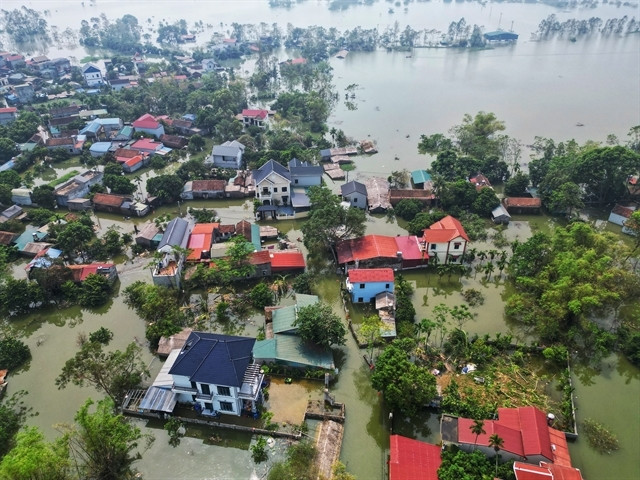 |
| Although the water levels in the rivers have begun to recede, many homes in Nhân Lý Village, Nam Phương Tiến Commune, Chương Mỹ District in the suburbs of Hà Nội, remain submerged as of Sunday and residents have not been able to return home. The forecast is for the destruction to last for another eight to ten days, affecting over 4000 households. — VNA/VNS Photo Tuấn Anh |
Super typhoon Yagi and its aftermath have left a trail of destruction in localities spanning from Thanh Hóa Province and northwards, with estimated loss of property so far reaching VNĐ40 trillion (US$1.6 trillion).
The figure was initial assessment by the Ministry of Planning and Investment and revealed at Sunday cabinet meeting on addressing the typhoon aftermath, chaired by Prime Minister Phạm Minh Chính.
The 26 provinces and cities in the northern region and Thanh Hóa that were affected by the typhoon account for over 41 per cent of the country's GDP and 40 per cent of the population.
To date, some localities are still experiencing flooding or face a high risk of further damage, which could exacerbate the overall losses.
Minister of Planning and Investment Nguyễn Chí Dũng stated that the impact of the typhoon is expected to slow down the growth rate of the country and many localities in the second half of the year.
Specifically, the country's GDP growth in the third quarter may suffer a decrease of 0.35 per cent, and by 0.22 per cent in the fourth quarter. For the entire year, GDP could decline by 0.15 per cent compared to the earlier growth scenario of 6.8-7 per cent.
The GRDP growth rate in 2024 for worst-hit localities such as Hải Phòng, Quảng Ninh, Thái Nguyên, and Lào Cai is expected to decrease by over 0.5 per cent.
Many roads are flooded or damaged, causing transportation activities (especially road and rail) to be disrupted locally.
Yagi was the most powerful typhoon in the East Sea (internationally known as the South China Sea) in the past 30 years, and the most powerful to hit mainland in 70 years.
Over 350 people were killed or remain missing to date.
The Ministry of Planning and Investment assessed that farms, rice and crop farmers, livestock households, and aquaculture are among the hardest hit, requiring significant resources and time to restock, replant, and resume production. Additionally, many tourism and accommodation facilities were damaged and had to close for repairs.
Industrial and construction enterprises were also affected by the typhoon, especially indirectly, due to power outages, communication disruptions, and the impact on workers and their families.
Minister Dũng stressed the importance of addressing social issues, especially in health, education, the environment, rural and urban clean water, labour, employment, and people's livelihoods. It called for prioritised resources and quick post-typhoon and flood recovery actions to prevent disease outbreaks and avoid further impacts on people's lives.
Moreover, the ministry urged the prompt restoration of infrastructure such as roads, bridges, drainage systems, electricity, water supply, telecommunications, and schools that were damaged.
It also underscored the urgent task of restoring the electricity system as quickly as possible, including both power sources and grids, and preparing technical backup plans to maintain the stability of the electricity dispatch system in case of an incident.
Particular priority should be given to providing power to industrial zones, industrial clusters, and manufacturing enterprises that supply materials for house repairs and production facilities. It is essential to repair power lines and substations while ensuring the safety of electricity use and providing information to guide production facilities and the public.
In addition, strict adherence to the operation procedures of multi-reservoir systems is necessary to ensure the safety of reservoirs and large upstream hydropower projects, which contribute to flood control in downstream areas. The ministry also stressed the need to closely monitor market developments and direct businesses to ensure the supply of gasoline and essential goods for the public.
The Ministry of Industry and Trade also proposed that localities coordinate closely with the electricity and trade sectors to fix issues at power generation facilities, transmission lines, and distribution systems, as well as to restore fuel supply systems and commercial facilities.
Localities should also prioritise facilitating and supporting the transportation and distribution of essential goods to areas isolated or cut off by flooding, and ensure a balanced supply of goods from less-affected regions to heavily-affected areas. — VNS